MERCEDES-BENZ SLC ROADSTER 2019 Workshop Manual
Manufacturer: MERCEDES-BENZ, Model Year: 2019, Model line: SLC ROADSTER, Model: MERCEDES-BENZ SLC ROADSTER 2019Pages: 306, PDF Size: 47.03 MB
Page 51 of 306
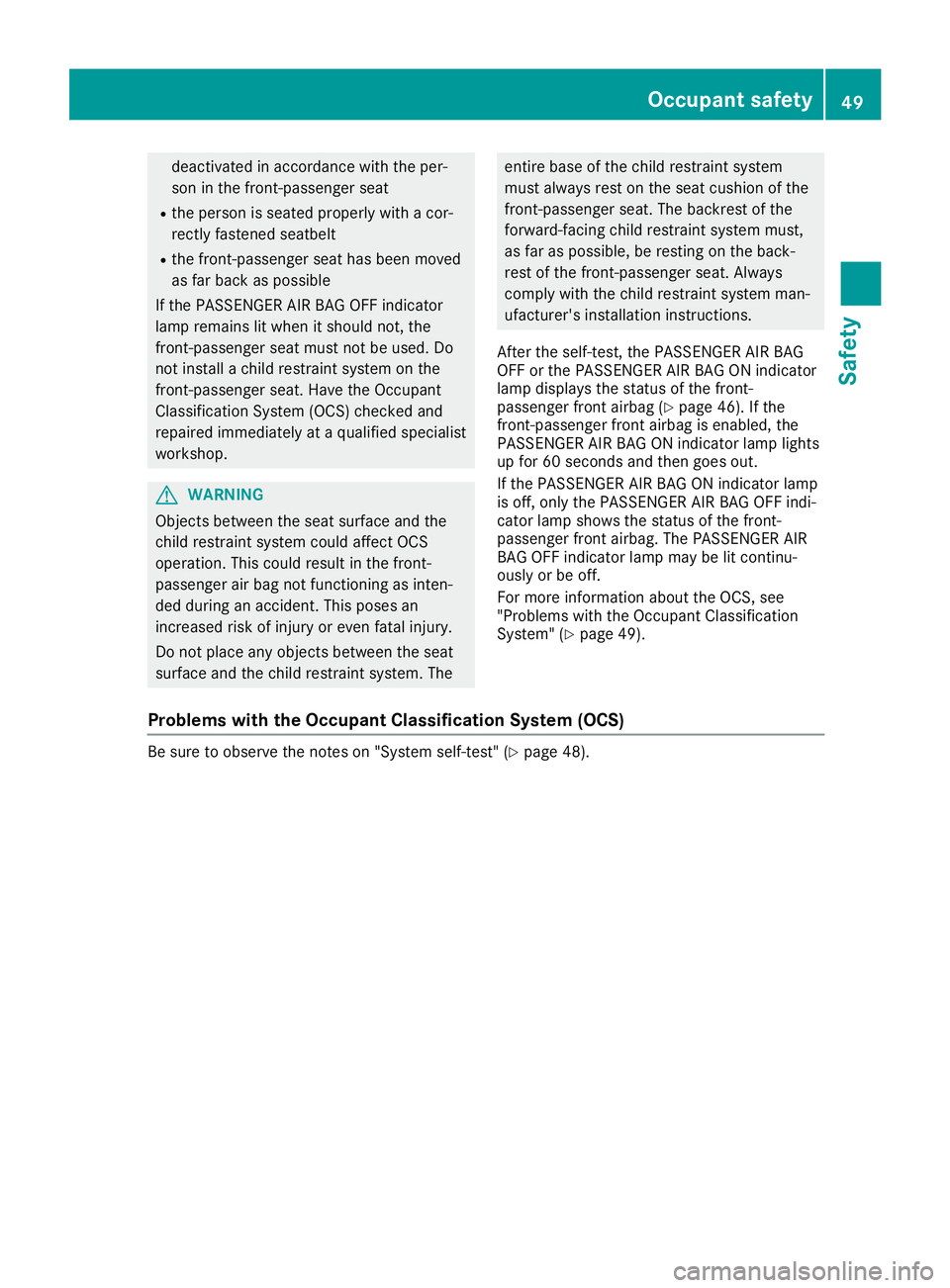
deactiv
atedinaccor dance withtheper-
son inthe fron t-passenger seat
R the person isseated properly withacor-
rect lyfasten edseatbelt
R the fron t-passenger seathasbeen moved
as far back aspossible
If the PAS SENGER AIRBAGOFF indicat or
lamp remains litwhen itshould not,the
fron t-passenger seatmust notbeused. Do
not installachild restraint system onthe
fron t-passenger seat.Have theOcc upant
Classification System(OCS)checkedand
repaired immediately ataqualified specialist
worksh op. G
WARN
ING
Objec tsbetween theseat surface andthe
child restraint system couldaffect OCS
operation .This could result inthe fron t-
passenger airbag notfunc tioningasinten-
ded during anacciden t.This poses an
incr eased riskofinjury oreven fatalinjury.
Do not place anyobjec tsbetween theseat
surface andthechild restraint system. The ent
irebase ofthe child restraint system
must always restonthe seat cushion ofthe
fron t-passenger seat.Thebackr estofthe
forward- facingchild restraint system must,
as far aspossible, berest ingonthe back-
rest ofthe fron t-passenger seat.Always
comply withthechild restraint system man-
ufactur er'sinstallation instruct ions.
Aft erthe self-t est,thePAS SENGER AIRBAG
OFF orthe PAS SENGER AIRBAGON indicat or
lamp displays thestatusofthe fron t-
passenger frontairbag (Ypage 46).Ifthe
fron t-passenger frontairbag isenabled, the
PAS SENGER AIRBAGON indicat orlamp lights
up for 60secon dsand then goes out.
If the PAS SENGER AIRBAGON indicat orlamp
is off, only thePAS SENGER AIRBAGOFF indi-
cator lampshows thestatusofthe fron t-
passenger frontairbag. ThePASSENGER AIR
BA GOFF indicat orlamp maybelitcon tinu-
ously orbe off.
For more information abouttheOCS, see
"Problems withtheOcc upant Classification
System "(Y page 49).
Problems withtheOccupant Classification System(OCS) Be
sure toobserve thenoteson "System self-test"(Ypage 48). Occupant
safety
49Safet y Z
Page 52 of 306
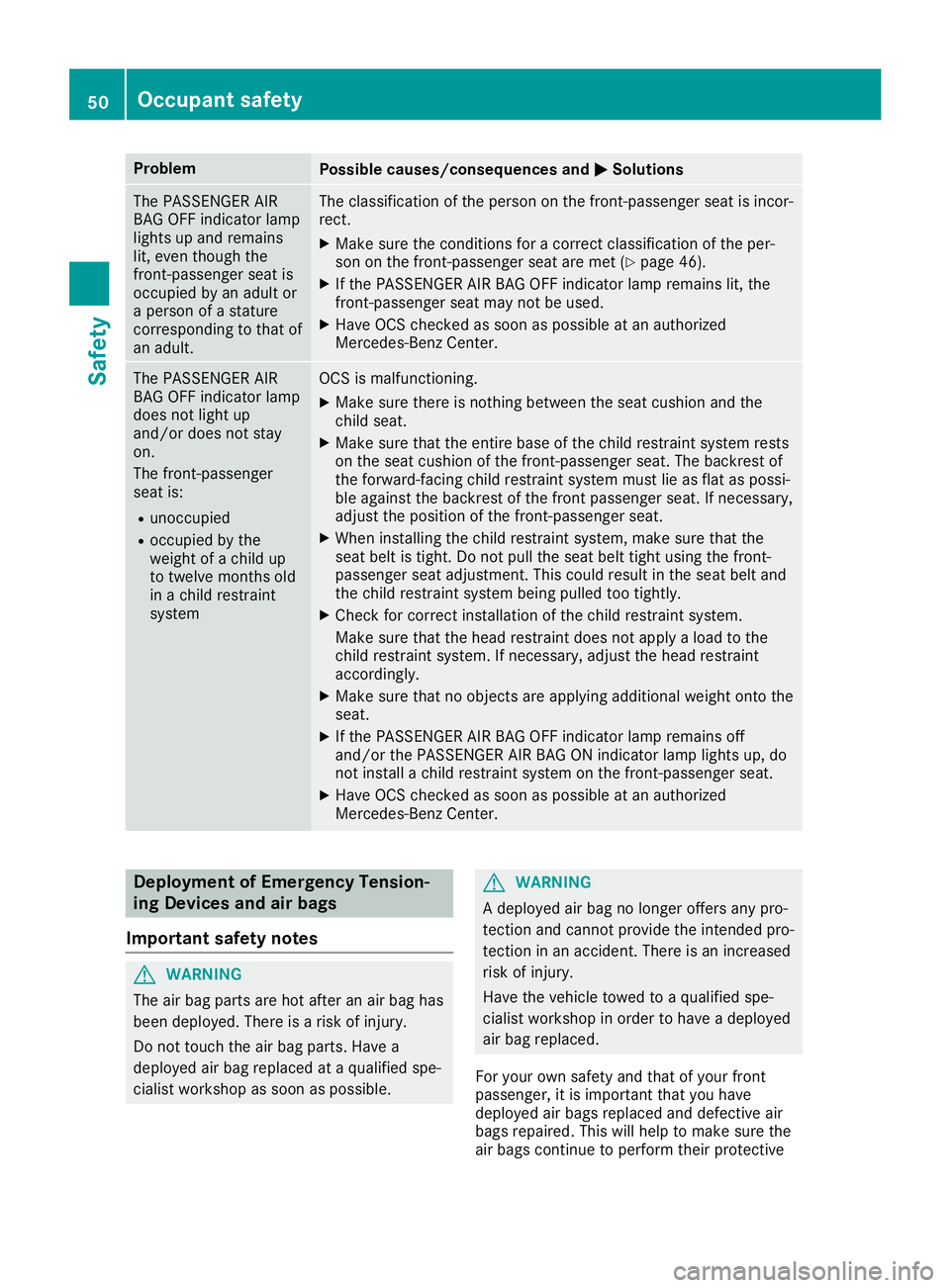
Problem
Possible
causes/co nsequences and0050 0050
Solutions The
PASS ENGER AIR
BAG OFFindicator lamp
lights upand remains
lit, even though the
front -passenger seatis
occupied byan adult or
a person ofastature
correspondin gto that of
an adult. The
classification ofthe person onthe front -passenger seatisincor-
rect.
X Make surethecondition sfor acorrect classification ofthe per-
son onthe front -passenger seataremet (Ypage 46).
X Ifthe PASS ENGER AIRBAG OFFindicator lampremains lit,the
front -passenger seatmaynotbeused.
X Have OCScheck edassoon aspossible atan authorized
Mercedes-Ben zCenter. The
PASS ENGER AIR
BAG OFFindicator lamp
does notlight up
and/or doesnotstay
on.
The front -passenger
seat is:
R unoccupied
R occupied bythe
weight ofachild up
to twelve monthsold
in achild restraint
system OCS
ismalfunctionin g.
X Make surethere isnothin gbetween theseat cushion andthe
child seat.
X Make surethattheentire baseofthe child restraint systemrests
on the seat cushion ofthe front -passenger seat.Thebackrest of
the forward-facing childrestraint systemmustlieasflat aspossi-
ble against thebackrest ofthe front passenger seat.Ifnecessary,
adjust theposition ofthe front -passenger seat.
X When installing thechild restraint system,makesurethatthe
seat beltistight. Donot pull theseat belttight using thefront -
passenger seatadjustment .This could result inthe seat beltand
the child restraint systembeingpulled tootightly.
X Check forcorrect installation ofthe child restraint system.
Make surethatthehead restraint doesnotapply aload tothe
child restraint system.Ifnecessary, adjustthehead restraint
accordingly.
X Make surethatnoobject sare apply ingadditional weightontothe
seat.
X Ifthe PASS ENGER AIRBAG OFFindicator lampremains off
and/or thePASS ENGER AIRBAG ONindicator lamplights up,do
not install achild restraint systemonthe front -passenger seat.
X Have OCScheck edassoon aspossible atan authorized
Mercedes-Ben zCenter. Deployment
ofEmergency Tension-
ing Devic esand airbags
Import antsafety notes G
WARNING
The airbag parts arehot after anair bag has
been deploye d.There isarisk ofinjury.
Do not touch theairbag parts. Havea
deploye dair bag replaced ataquali fiedspe-
cialist workshop assoon aspossible. G
WARNING
A deploye dair bag nolonger offersanypro-
tect ionand cannot provide theinten dedpro-
tect ioninan accident. Thereisan increased
risk ofinjury.
Have thevehicle towedtoaquali fiedspe-
cialist workshop inorder tohave adeploye d
air bag replaced.
For your ownsafety andthat ofyour front
passenger, itis important thatyouhave
deploye dair bags replaced anddefective air
bags repaired. Thiswillhelp tomake surethe
air bags continue toperform theirprotect ive 50
Occ
upantsafetySafety
Page 53 of 306
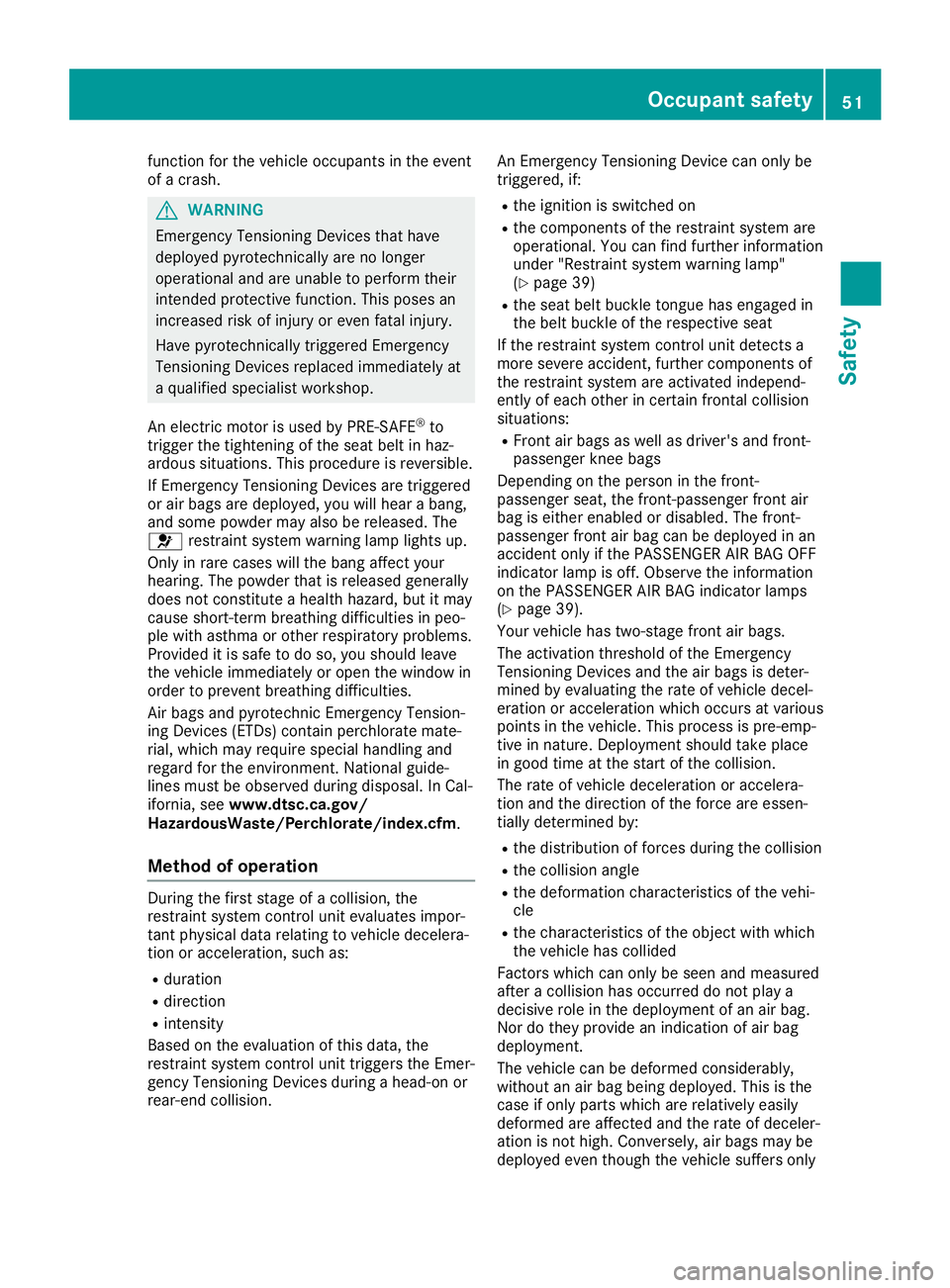
function
forthe vehicl eoccupa ntsinthe event
of acrash. G
WARNING
Emergency TensioningDevices thathave
depl oyedpyro technical lyare nolonge r
opera tional andareunab leto perform their
intended protective function.Thispose san
increas edrisk ofinjury oreven fatalinjury .
Have pyrotechnical lytrigger edEmergency
Tensio ningDevices replaced immed iatelyat
a qua lified speci alist worksho p.
An electric motor isuse dby PRE-SAFE ®
to
trigger thetightening ofthe seatbel tin haz-
ardo ussitua tions. Thisproced ureisreversi ble.
If Emergency TensioningDevices aretrigger ed
or air bag sare depl oyed,you willhea ra bang,
and some powdermay alsobe rele ased.The
0075 restrai ntsystem warning lamplig hts up.
Only inrare cases willthe bang affect your
hea ring. Thepowderthat isrele asedgenera lly
does notconstitute ahea lthhaza rd,but itmay
caus eshort-term breathing difficulti esinpeo-
ple with asthma orother respiratory problems.
Provid editis safe todo so, you shou ldlea ve
the vehicl eimmed iatelyor open thewind owin
order toprevent breathing difficulti es.
Air bag sand pyro technic Emergency Tension-
ing Devices (ETDs)contain perchloratemate-
rial ,whi chmay requirespeci alhandl ingand
rega rdfor the environment. Nationalguide-
lines must beobse rved duringdisp osal.In Ca l-
ifornia ,see www.dtsc.c a.gov/
HazardousWaste/ Perchlorate/i ndex.cfm.
Method ofoperatio n During
thefirst stage ofacolli sion, the
restrai ntsystem controlunitevaluates impo r-
tant physical datarelating tovehicl edecel era-
tion oraccele ration, suchas:
R dura tion
R dire ction
R intensity
Based onthe eval uation ofthis data ,the
restrai ntsystem controlunittrigger sthe Emer-
gency TensioningDevices duringahea d-on or
rear-end collision. An
Emergency TensioningDevice canonly be
trigger ed,if:
R the igniti onisswi tched on
R the components ofthe restrai ntsystem are
opera tional.You canfind further informa tion
under "Restrai ntsystem warning lamp"
(Y pag e39)
R the seatbel tbuckle tongue hasengag edin
the beltbuckle ofthe respe ctiveseat
If the restrai ntsyste mcontrol unitdetects a
more severe accident,further components of
the restrai ntsyste mare activa tedindep end-
ently ofeach other incertain frontalcollision
situa tions:
R Front airbag sas wel las drive r'sand front-
pas senger kneebags
Dependi ngon the perso nin the front-
pas senger seat,the front-passe ngerfront air
bag iseither enabledordisa bled.The front-
pas senger frontairbag canbedepl oyedin an
accid entonly ifthe PASSENGER AIRBAG OFF
indica torlam pis off. Obser vethe informa tion
on the PASSENGER AIRBAG indica torlam ps
(Y pag e39) .
You rvehicl ehas two-stage frontairbag s.
The activa tionthreshol dof the Emergency
Tensio ningDevices andtheairbag sis deter-
mined byeval uating therate ofvehicl edecel -
erati onoraccele rationwhichoccurs atvari ous
poi nts inthe vehicl e.This process ispre-emp -
tive innature. Deployment shouldtake place
in good timeatthe start ofthe colli sion.
The rate ofvehicl edecel erationoraccele ra-
tion andthedirection ofthe force areessen-
tial lydetermi nedby:
R the distri butionofforces duringthe colli sion
R the colli sion angle
R the deforma tionchara cteristics ofthe vehi-
cle
R the chara cteristics ofthe object withwhich
the vehicl ehas collided
Factors whichcan only beseen andmeas ured
after acolli sion hasoccurred donot playa
decis iverole inthe depl oyme ntofan air bag .
Nor dothey provi deanindica tionofair bag
depl oyme nt.
The vehicl ecan bedeforme dconside rably,
witho utan air bag being depl oyed.This isthe
case ifonly parts whichare relatively easily
deforme dare affected andtherate ofdecel er-
ation isnot high .Convers ely,air bag smay be
depl oyedeven though thevehicl esuffe rsonly Oc
cupant safety
51Safety Z
Page 54 of 306
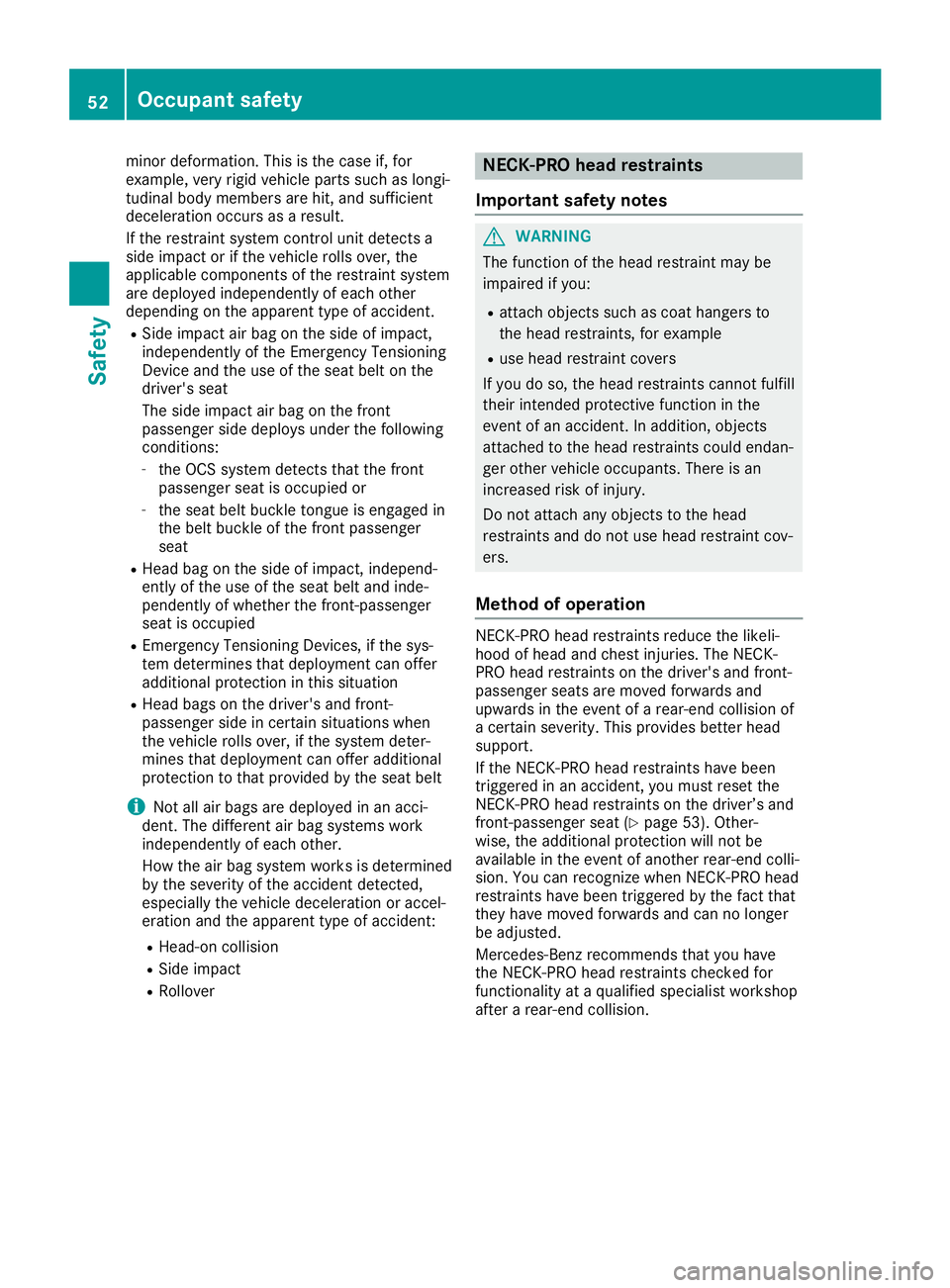
minor
deforma tion.Thisisthe case if,for
exampl e,very rigid vehicl eparts suchaslongi-
tudina lbody members arehit,and suffici ent
decel eratio noccurs asaresul t.
If the restraint systemcontrolunitdetects a
side impa ctor ifthe vehicl erolls over, the
app licable components ofthe restraint system
are depl oyedindepe ndently ofeach other
depe nding onthe apparent typeofaccide nt.
R Side impactair bag onthe side ofimpa ct,
indepe ndently ofthe Emergency Tensioning
Device andtheuse ofthe seat beltonthe
driver' sseat
The side impa ctair bag onthe front
pass enger sidedeploysunder thefollo wing
conditions:
- the OCS system detects thatthefront
pass enger seatisoccupi edor
- the seat beltbuckle tongue isengage din
the belt buckle ofthe front passenger
seat
R Head bagonthe side ofimpa ct,indepe nd-
ently ofthe use ofthe seat beltandinde-
pendently ofwhethe rthe front-passenger
seat isoccupi ed
R Emergency TensioningDevices, ifthe sys-
tem determines thatdeployme ntcan offer
add itional protection inthis situa tion
R Head bagsonthe driver' sand front-
pass enger sideincertain situations when
the vehicl erolls over, ifthe system deter-
mines thatdeployme ntcan offer additional
protection tothat provid edbythe seat belt
i Not
allair bags aredepl oyedin an acci-
dent. Thediffere ntair bag systems work
indepe ndently ofeach other.
How theairbag system worksisdetermined
by the severi tyof the accide ntdetected,
especi allythe vehicl edecel eratio nor accel-
eratio nand theapparent typeofaccide nt:
R Head-on collision
R Side impact
R Rol lover NECK
-PROhead restraints
Important safetynotes G
WARNING
The function ofthe head restraint maybe
impa iredifyou :
R attach objects suchascoat hangers to
the head restraints, forexampl e
R use head restraint covers
If you doso, the head restraints cannotfulfill
their intended protective functioninthe
event ofan accide nt.Inadd ition, objects
attached tothe head restraints couldendan-
ger other vehicleoccupa nts.There isan
increase drisk ofinjury.
Do not attach anyobjects tothe head
restraints anddonot use head restraint cov-
ers.
Method ofoperation NECK-PRO
headrestraints reducethe likel i-
hood ofhead andchest injurie s.The NECK-
PRO head restraints onthe driver' sand front-
pass enger seatsaremoved forwardsand
upw ards inthe event ofarear-end collision of
a certain severity.This provid esbetter head
supp ort.
If the NECK-PRO headrestraints havebeen
triggere din an accide nt,you must reset the
NECK-PRO headrestraints onthe driver’ sand
front-passenger seat(Ypage 53).Other-
wise ,the additional protection willnot be
avai lablein the event ofanother rear-end colli-
sion. Youcanrecognize whenNECK-PRO head
restraints havebeen triggered bythe fact that
they have moved forwardsand cannolonger
be adju sted.
Mercede s-Benzrecommends thatyouhave
the NECK-PRO headrestraints checkedfor
functionali tyat aqua lified specia listworkshop
after arear-end collision. 52
Occ
upant safetySafety
Page 55 of 306
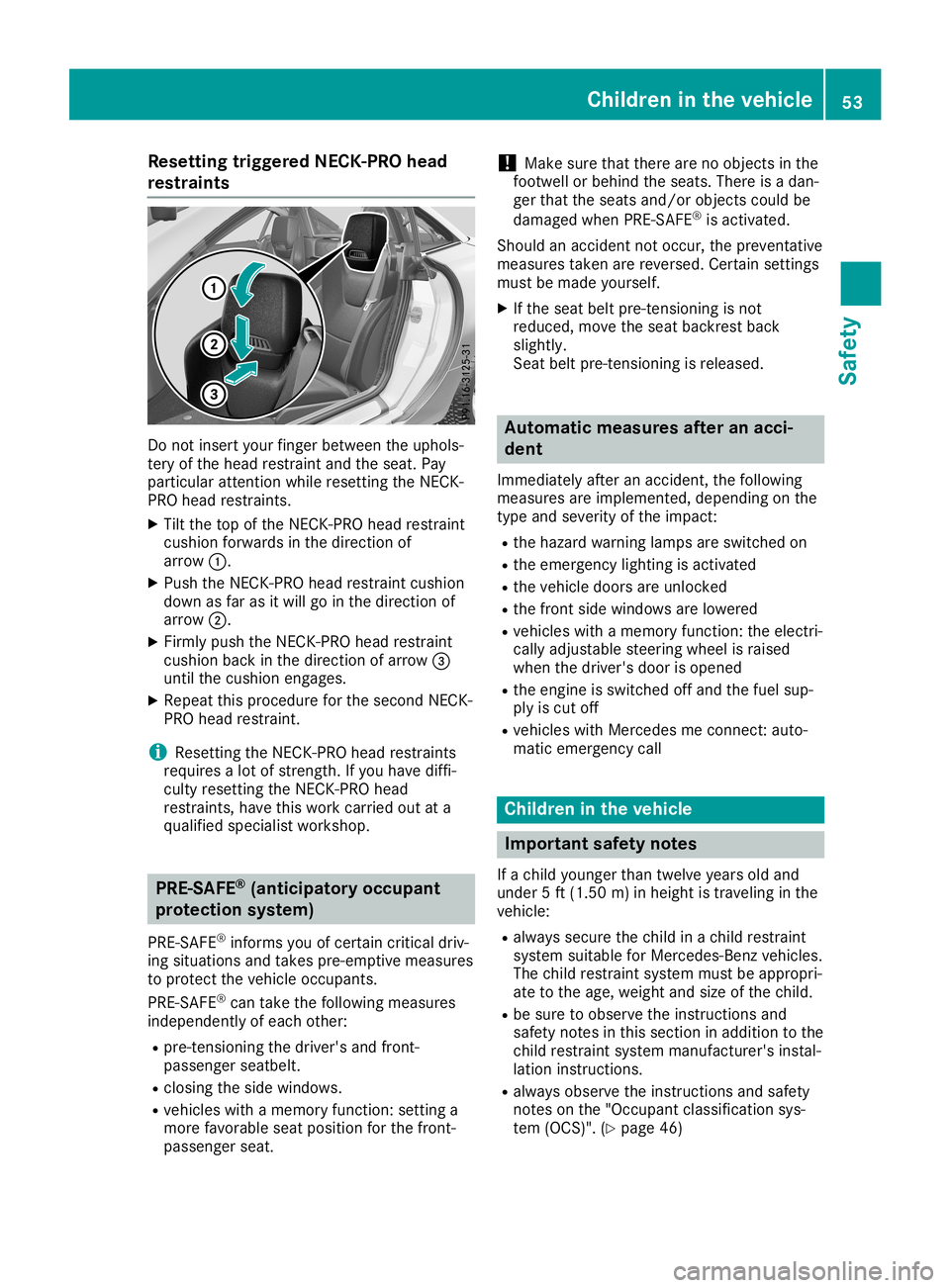
Res
ettingtrigg eredNEC K-PRO head
res traints Do
not inse rtyo ur fing erbetw eentheuphol s-
tery ofthe headres trai ntand theseat.Pa y
pa rticu larattenti onwhile res etting theNECK -
PR Ohea dres trai nts.
X Tilt the top ofthe NECK -PROhea dres trai nt
cus hionforw ardsin the directi onof
arr ow 0043.
X Pu sh the NECK -PROhea dres trai ntcus hion
dow nas far asitwi llgo inthe directi onof
arr ow 0044.
X Firm lypu sh the NECK -PROhea dres trai nt
cus hionba ck inthe directi onofarr ow 0087
unti lthe cushionenga ges.
X Re pea tthis proced ure forthe seco ndNECK -
PR Ohea dres trai nt.
i Re
setti ngthe NECK -PROhea dres trai nts
req uires alotof streng th.Ifyo uha ve diffi-
cul tyres etting theNECK -PROhea d
res trai nts, have this workcarr ied ou tat a
qu alifi ed spe cialist wo rksho p. PRE
-SAFE®
(an ticipato ryoccupa nt
prote ction sys tem)
PR E-SAFE ®
info rms youof certa incriti caldriv-
ing situ ations and take spre -emp tivemea sures
to pro tect thevehicleoccu pants.
PR E-SAFE ®
can take thefollowi ng mea sures
ind epe ndentl yof each othe r:
R pre -tensi oning thedriver' sand front-
pa sse nger seatbel t.
R clo sing thesidewi ndow s.
R veh icles with amemo ryfuncti on:setti nga
more favora ble sea tpos ition for the front-
pa sse nger seat. !
Ma
kesure that there arenoobje ctsinthe
foo twe llor beh indthe seats.The reisada n-
ger that theseatsand /or obje ctscou ldbe
da mag edwhen PRE-SAFE ®
is acti vate d.
Shou ldan acci dent notoccu r,the preventa tive
mea sures take nare reve rsed.Ce rtai nsetti ngs
mus tbe mad eyo urs elf.
X Ifthe seatbel tpre -tensi oning isnot
red uce d,move theseatba ckrest back
sli ghtl y.
Sea tbel tpre -tensi oning isrel eased . Auto
matic measuresafter anacc i-
den t
Imme diate lyafte ran acci dent, thefollowi ng
mea sures are implemente d,dep endi ngon the
typ eand severityof the impact:
R the hazard warning lamps areswitched on
R the eme rgency lighti ngisacti vate d
R the vehicledoo rsare unlocked
R the front sidewi ndow sare lowe red
R veh icles with amemo ryfuncti on:the electri -
cal lyad justa ble stee ring wheel israi sed
wh en the driver' sdoo ris ope ned
R the engi neisswi tched offand thefuelsu p-
pl yis cut off
R veh icles with Mer cedesme connect: auto-
mati ceme rgency call Chi
ldre nin the vehic le Impo
rtant safetynotes
If achi ldyoung erthan twelveyears old and
und er5ft (1.50 m)inhe ight istra vel ing inthe
veh icle:
R alwa yssecur ethe childinachi ldres traint
sy ste msuita ble for Merced es-Benz vehicles .
The childres traint syste mmu stbe appro pri-
ate tothe age, we ight and size ofthe child.
R be sure to observe the instructio nsand
sa fety note sin thi sse ctio nin ad ditio nto the
chi ldres traint syste mma nuf actu rer'sins tal-
la tio nins tructio ns.
R alwa ysobserve the instructio nsand safety
note son the "Occu pant cla ssificati on sys-
tem (OCS) ".(Y page 46) Ch
ildren inthe vehic le
53Safe ty Z
Page 56 of 306
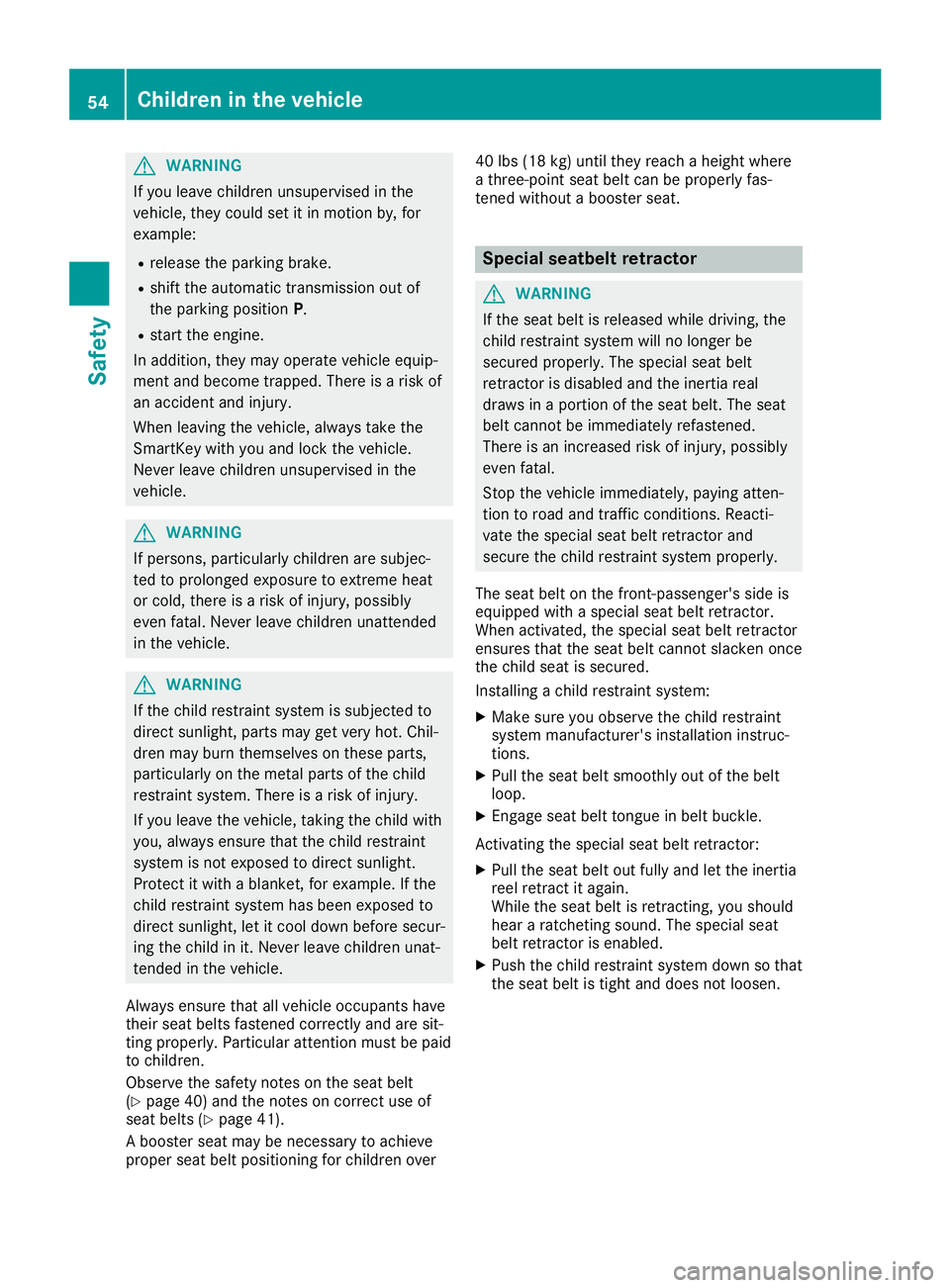
G
WARNING
If you leavechild renunsu pervi sedinthe
vehicl e,they couldset itin motion by,for
exampl e:
R rele ase theparki ngbrake.
R shift theautomatic transmissi onout of
the parki ngposi tion P.
R start theengine.
In add ition, theymayopera tevehicl eequ ip-
ment andbecome trapped.There isarisk of
an accide ntand injury .
When leaving thevehicl e,alw aystake the
SmartKey withyouand lock thevehicl e.
Never leavechild renunsu pervi sedinthe
vehicl e. G
WARNING
If perso ns,particu larlychild renaresubjec-
ted toprolo nged exposu reto extreme heat
or cold, there isarisk ofinjury ,possi bly
even fatal.Never leavechild renunattended
in the vehicl e. G
WARNING
If the child restrai ntsystem issub jected to
dire ctsunli ght,parts maygetvery hot.Chil-
dren mayburn themsel vesonthese parts,
particu larlyon the metal partsofthe child
restrai ntsystem. Thereisarisk ofinjury .
If you leavethe vehicl e,taking thechild with
you ,alw aysensure thatthechild restrai nt
system isnot expose dto dire ctsunli ght.
Protect itwith abla nket, forexampl e.Ifthe
child restrai ntsystem hasbeen expose dto
dire ctsunli ght,letitcool downbefore secur-
ing the child init. Never leavechild renunat-
tended inthe vehicl e.
Alwa ysensure thatallvehicl eoccupa ntshave
their seatbeltsfastened correctly andaresit-
ting prope rly.Particu larattention mustbepaid
to child ren.
Observe thesafety notesonthe seat belt
(Y pag e40) and thenotes oncorrect useof
seat belts(Y pag e41).
A booster seatmaybenecessa ryto achie ve
prope rseat beltposi tioning forchild renover 40
lbs (18 kg)until theyreach aheig htwhere
a three-poi ntseat beltcan beprope rlyfas-
tened withoutabooster seat. Spec
ialseatbe ltretractor G
WARNING
If the seat beltis rele ased whiledrivi ng,the
child restrai ntsystem willno longer be
secure dprope rly.The speci alseat belt
retractor isdisa bledand theinertia real
draw sin aportion ofthe seat belt.The seat
bel tcannot beimmed iatelyrefastene d.
There isan increas edrisk ofinjury ,possi bly
even fatal.
Stop thevehicl eimmed iately,pay ing atten-
tion toroad andtraffic conditions. Reacti-
vate thespeci alseat beltretractor and
secure thechild restrai ntsystem properly.
The seat belton the front-passenge r'sside is
equ ipped with aspeci alseat beltretractor.
When activated,thespeci alseat beltretractor
ensure sthat theseat beltcannot slacken once
the child seatissecure d.
Install ingachild restrai ntsystem:
X Make sureyouobser vethe child restrai nt
system manufacturer's installationinstruc-
tions.
X Pul lthe seat beltsmoothly outofthe belt
loop .
X Engage seatbelttongue inbel tbuckle .
Activating thespeci alseat beltretractor:
X Pul lthe seat beltout fullyand letthe inertia
reel retract itaga in.
Whil ethe seat beltis retracting, youshou ld
hear aratcheting sound.The speci alseat
bel tretractor isenabl ed.
X Push thechild restrai ntsystem downso that
the seat beltis tight anddoes notloos en. 54
Chi
ldren inthe vehi cleSafety
Page 57 of 306
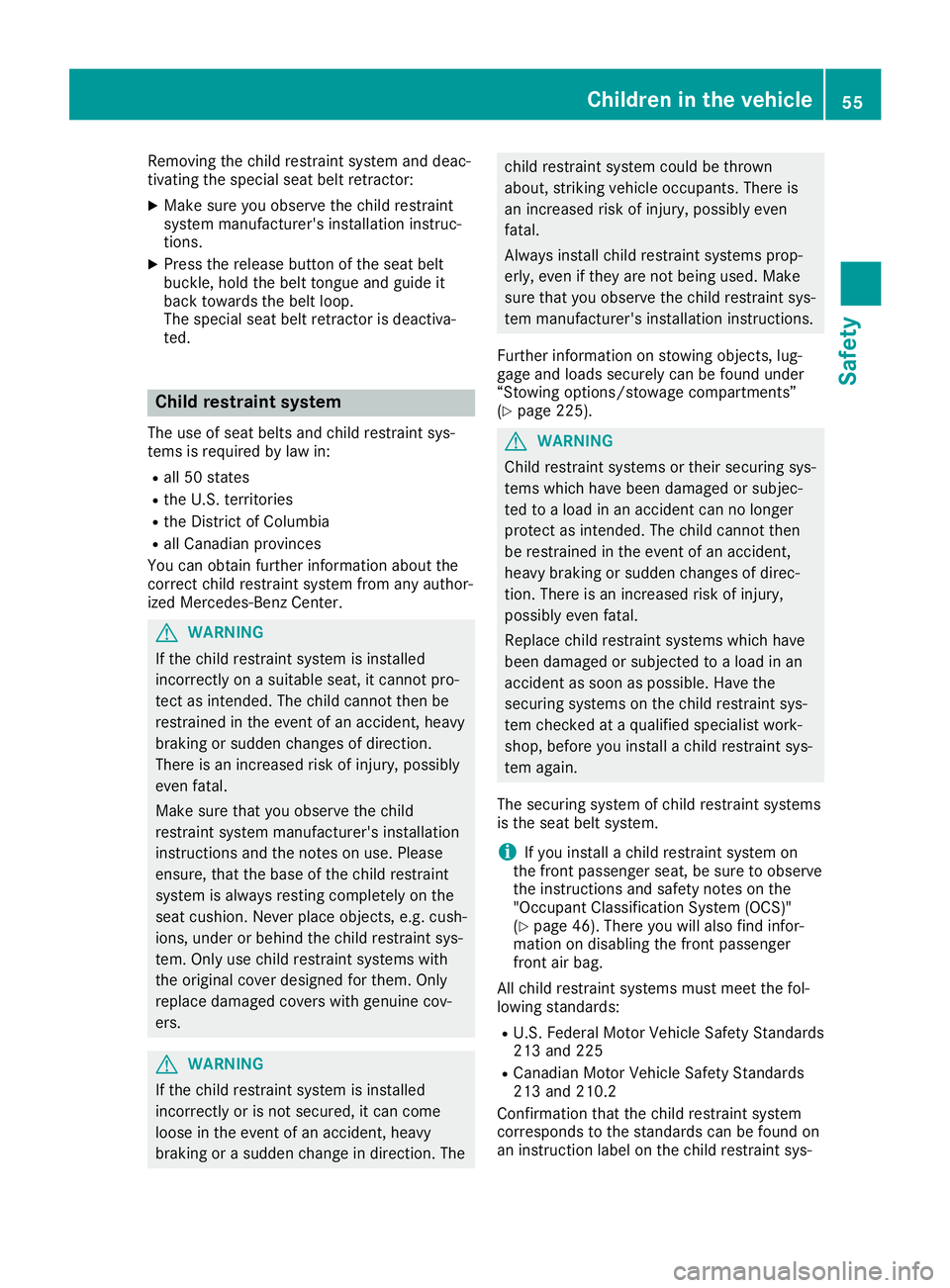
Remo
vingth ech ild res train tsyst emand deac -
ti vat ing thespec ialseat beltretrac tor:
X Mak esur eyou observeth ech ild res train t
syst emman ufacturer'sins tallation instruc-
ti on s.
X Pre sstherel ease buttonof theseat belt
buc kle,hold thebelt tong ue and guide it
bac kto wards thebelt loop.
The spec ialseat beltretrac toris deac tiva-
te d. Child
restrain tsys tem
The useofseat beltsand child res train tsys-
te ms isreq uire dby law in:
R all 50 state s
R theU. S. territori es
R theDi stric tof Colum bia
R all Canad ianprovinces
You canobtain further inform ation about the
co rrec tch ild res train tsyst emfrom any auth or-
iz ed Mer cedes- BenzCen ter. G
WAR
NING
If th ech ild res train tsyst emisins talled
inc orrectly on asuit able seat,it can notpro -
te ct as intended. Thechild can notth en be
res train ed intheeve ntofan acc iden t,heav y
brak ingorsudde nch ang esofdire ction .
The reisan increas edriskof injury, possibly
eve nfat al.
Mak esur eth at you observeth ech ild
res train tsyst emman ufacturer'sins tallation
ins truct ionsand theno teson use. Pleas e
en sur e,that thebase ofthech ild res train t
syst emisalways resting comple tely on the
seat cushion .Nev erplac eobj ects,e. g. cus h-
ion s,und eror behi ndthech ild res train tsys-
te m. Onlyuse child res train tsyst ems with
th eori gin alco ver desi gned for them. Only
rep lace damag edcover swit hgen uine cov-
ers . G
WAR
NING
If th ech ild res train tsyst emisins talled
inc orrectly or isno tsec ured ,it can come
loos ein theeve ntofan acc iden t,heav y
brak ingorasudde nch ang ein dire ction .The ch
ild res train tsyst emcould bethrow n
about ,st rik ing vehicleoc cup ants.The reis
an increas edriskof injury, possiblyeve n
fat al.
Alw ays installch ild res train tsyst ems prop-
erl y,eve nif th ey are notbein gused .Mak e
sur eth at you observeth ech ild res train tsys-
te m man ufacturer'sins tallation instruct ions.
Fur ther inform ation onstowin gobj ects,lug-
gage andloads securel ycan befoun dund er
“S towin gopt ions/stowage compar tments”
(Y page 225). G
WAR
NING
Child restrain tsyst ems ortheir sec urin gsys-
te ms whic hhav ebeen damag edorsubj ec-
te dto aload inan acc iden tcan nolonger
pro tect as intended. Thechild can notth en
be res train ed intheeve ntofan acc iden t,
heav ybrak ingorsudde nch ang esofdire c-
ti on .The reisan increas edriskof injury,
pos siblyeve nfat al.
Replac ech ild res train tsyst ems whichhav e
been damag edorsubj ectedto aload inan
acc iden tas soo nas pos sible.Hav eth e
sec urin gsyst ems onthech ild res train tsys-
te m checke dat aqualif iedspec ialist work-
sho p,bef ore you installa ch ild res train tsys-
te m again .
The securin gsyst emofchild res train tsyst ems
is theseat beltsystem.
i If
you installa ch ild res train tsyst emon
th efron tpass enger seat ,be sur eto obs erve
th eins truct ionsand safetyno teson the
"Oc cup ant Class ification Sys tem (OCS )"
(Y page 46).The reyou willalso findinf or-
mat ionondisab lingth efron tpass enger
fr on tair bag.
All child res train tsyst ems mustmee tth efol -
lowin gst and ards :
R U.S. Fed eral MotorVeh icleSaf etySt and ards
21 3and 225
R Canad ianMot orVeh icleSaf etySt and ards
21 3and 210.2
Con firmat ionthat thech ild res train tsyst em
co rrespo ndsto thest and ards canbefoun don
an instruct ion label onthech ild res train tsys- Child
renintheveh icle
55Safet y Z
Page 58 of 306
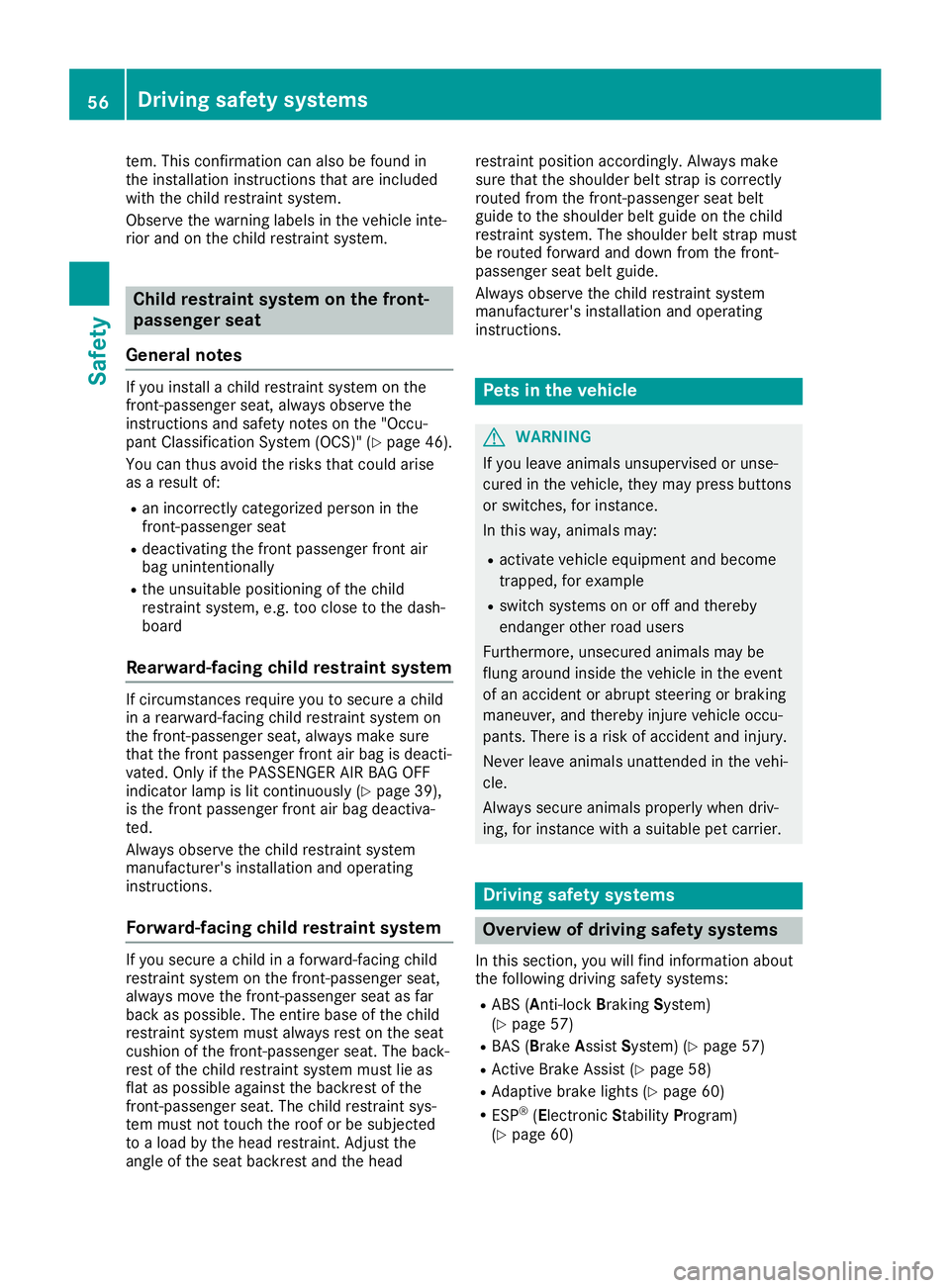
tem.
Thisconfi rmationcan also be fou ndin
the installatio nins tructio nstha tar eincl uded
wi th the childres traint syste m.
Ob serve the warning labe lsin the vehicleinte -
rio rand onthe childres traint syste m. Ch
ild res train tsys tem onthe front-
pass engerse at
Ge neral notes If
yo uins talla chi ldres traint syste mon the
fro nt-pa ssenge rse at, alwa ysobserve the
ins tructio nsand safety note son the "Occu -
pa nt Clas sific ati on Sys tem (OCS) "(Y page 46) .
Yo ucan thusav oid the risks tha tcou ldarise
as ares ultof:
R an inco rrectly cate gorized perso nin the
fro nt-pa ssenge rse at
R de acti vating thefrontpasse nge rfro ntair
ba guni ntenti onally
R the unsuitab lepo sitio ning ofthe child
res traint syste m, e.g.too closetothe dash-
bo ard
Rea rwa rd-fac ingch ild res train tsys tem If
cir cum stances require youto secur eachi ld
in area rward-fa cing childres traint syste mon
the front-pa ssenge rse at, alwa ysma kesure
tha tthe frontpasse nge rfro ntairba gis de acti -
va ted .Onl yif the PASSEN GERAIRBAG OFF
ind icator lamp islit conti nuously(Y page 39),
is the frontpasse nge rfro ntairba gde acti va-
ted .
Alw aysob serve the childres traint syste m
ma nuf actu rer'sins tallatio nand opera ting
ins tructio ns.
Fo rwa rd-fac ingch ild res train tsys tem If
yo use cur eachi ldinafor wa rd-f acing child
res traint syste mon the front-pa ssenge rse at,
al wa ysmov ethe front-pa ssenge rse at as far
ba ck aspossi ble. The entirebase ofthe child
res traint syste mmu stalwa ysres ton the seat
cus hion ofthe front-pa ssenge rse at. The back-
res tof the childres traint syste mmu stlie as
fla tas possi ble ag ainst the backre stof the
fro nt-pa ssenge rse at. The childres traint sys-
tem mustnot touchthe roofor be subje cted
to aload bythe head res traint. Adju stthe
ang leof the seat backre stand thehead res
traint positio nacc ordingly.Alw aysma ke
su re tha tthe shoulde rbe ltstra pis corr ectly
rou ted fromthe front-pa ssenge rse at belt
gu ide to the shoulde rbe ltgu ide on the child
res traint syste m. Thesho ulde rbe ltstra pmu st
be rou ted forwa rdand down fromthe front-
pa sse nge rse at beltgu ide.
Alw aysob serve the childres traint syste m
ma nuf actu rer'sins tallatio nand opera ting
ins tructio ns. Pe
ts inthe vehic le G
WA
RNING
If yo uleav eani ma lsuns uperv ised oruns e-
cur edinthe vehicle, the yma ypre ssbuttons
or sw itch es,for instance .
In thi swa y,ani ma lsma y:
R acti vate veh icleeq uipme ntand become
tra pped,for exa mpl e
R sw itch syste ms onoroff and thereb y
end angerothe rroa dus ers
Fur thermo re,uns ecu red anima lsma ybe
flu ng arou nd inside the vehiclein the event
of an acc ident orabrupt ste ering orbra king
ma neu ver,and thereb yinju reveh icleoccu -
pa nts. There isaris kof acc ident and injury.
Nev erleav eani ma lsuna ttend edinthe vehi-
cle .
Alw aysse cur eani ma lspro perly when driv-
ing ,for instance with asu ita ble pe tcar rier. Dri
ving safety systems Ov
erv iew of driv ingsaf ety systems
In thi sse ctio n,youwi llfin dinf orm ation abou t
the followi ng drivin gsa fety syste ms:
R ABS (Anti -lock Braki ng Syste m)
(Y page 57)
R BAS (Bra keAssist Sy ste m) (Ypage 57)
R Activ eBra keAssi st(Y page 58)
R Ada ptive bra kelights (Ypage 60)
R ESP ®
(El ectr onicSta bility Pro gram)
(Y page 60) 56
Dr
ivi ng safet ysy stem sSafet y
Page 59 of 306
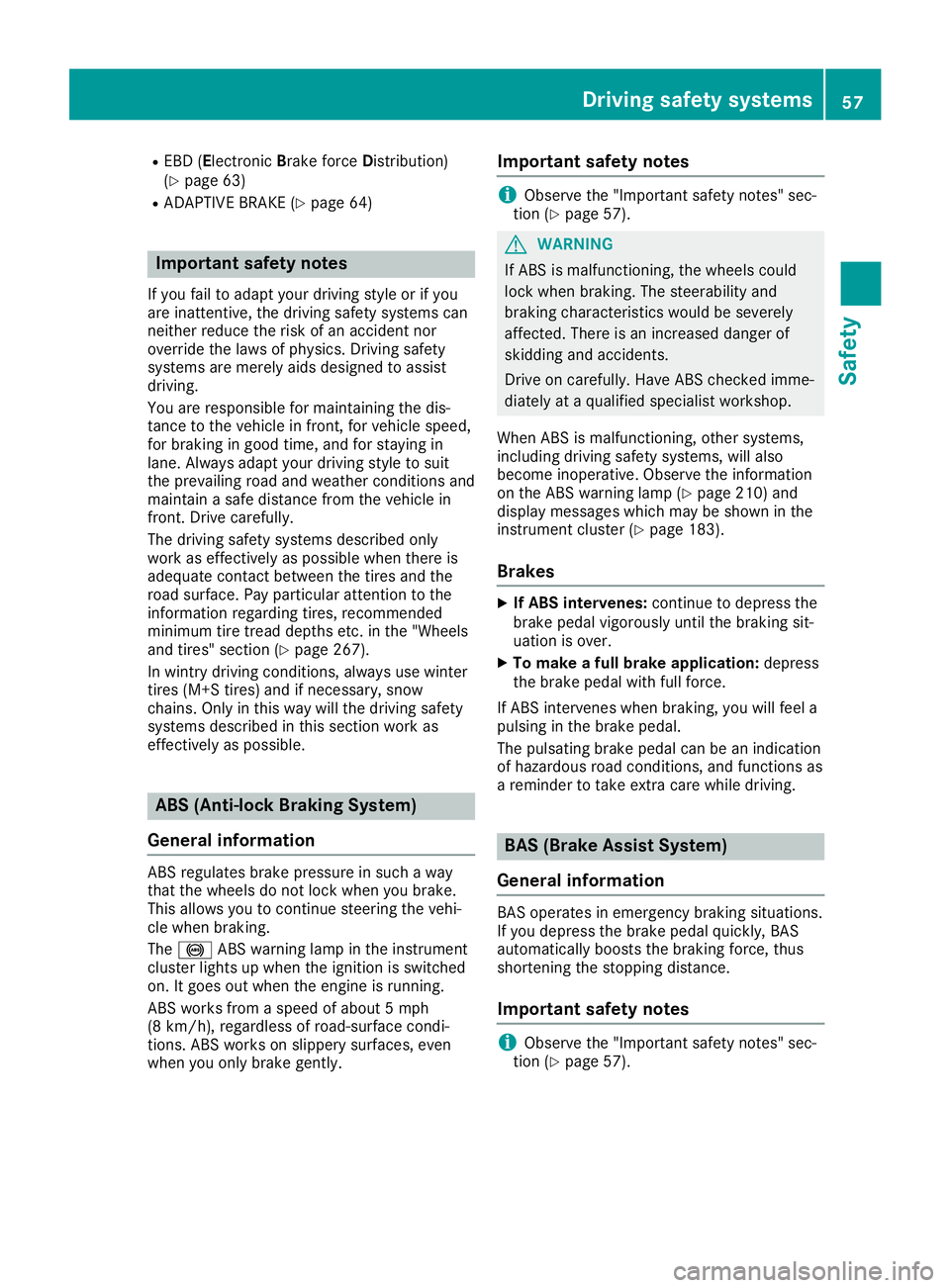
R
EBD (El ectro nicBrakeforce Dis trib ution)
(Y page 63)
R ADAPT IVEBRA KE(Ypage 64) Impo
rtant safety notes
If yo ufa ilto adaptyo ur drivin gsty leor ifyo u
ar eina ttenti ve,the drivin gsa fety system scan
nei the rred uce theriskof an acc ident nor
ove rride the laws ofphysics .Driv ingsafety
sy stem sar emer elyai ds designe dto assist
dri vin g.
Yo uar eres ponsi ble for mainta ining the dis-
tance tothe vehiclein fro nt, for veh iclesp ee d,
for braking ingo od time ,and forstaying in
la ne. Alwaysad aptyo ur drivin gsty leto suit
the prevailing roadand weath ercond itions and
ma inta inasa fe dista nce fromthe vehiclein
fro nt. Driv ecar efully.
The drivin gsa fety system sde scri bedonl y
wo rkas effecti velyas possi ble wh en the reis
ad eq uate conta ctbetwe enthe tiresand the
roa dsu rfa ce. Paypa rtic ular atte ntionto the
info rma tionreg arding tire s,reco mme nded
min imumtire trea dde pth setc. inthe "Wheels
and tires"sec tion(Y page 267) .
In wintry drivin gcond itions, alwa ysusewi nter
tire s(M +S tire s)and ifnece ssary,snow
cha ins.Onl yin thi swa ywi llthe drivin gsa fety
sy stem sde scri bedin thi ssec tionwo rkas
eff ecti velyas possi ble. ABS
(Anti -lock Braki ngSys tem)
Ge neral info rmatio n ABS
regulate sbra kepre ssu reinsuch awa y
tha tthe wheelsdo not lock when youbra ke.
Thi sal lo ws youto conti nuesteeringthe vehi-
cle when bra king .
The 0025 ABSwarning lamp inthe instrument
clu ster lights upwhen the igniti onissw itch ed
on. Itgo es outwh en the engineisrunning .
ABS works fromasp ee dof abou t5 mph
(8 km/h ),reg ardless ofroa d-surface cond i-
tio ns. ABS works onslip pe ry surfa ces ,eve n
wh en youonl ybra kegently . Impo
rtant safety notes i
Ob
ser vethe "Impo rtantsafety note s"sec -
tio n(Y page 57) . G
WA
RNING
If ABS isma lfunctio ning,the wheelscou ld
lo ck when bra king .The stee rability and
bra king characteri stics wo uld be sev erely
af fecte d.The reisan incr eased dange rof
ski dding and accidents .
Driv eon car efully. Hav eABS checked imme-
di ate lyat aqu alifi ed speci alistwo rksh op.
Wh enABS isma lfunctio ning,othe rsy stem s,
incl uding drivin gsa fety system s,willal so
be come inoperative .Ob ser vethe informa tion
on the ABS warning lamp (Ypage 210 )and
di sp laymes sage swh ich maybe sho wninthe
ins trument cluster (Ypage 183 ).
Brake s X
IfABS interv enes:conti nuetodepre ssthe
bra kepedalvig oro uslyunti lthe braking sit-
ua tio nis ove r.
X To make aful lbrak eappl icatio n:depre ss
the brakepedalwi th fullfor ce.
If ABS intervenes when bra king ,yo uwi llfee la
pu lsing inthe brakepedal.
The pulsati ng bra kepedalcan beanind ication
of hazar dous roa dcond itions, andfunctio nsas
a rem inderto take extra carewh ile dri vin g. BAS
(Brak eAs sist Sys tem)
Ge neral info rmatio n BAS
opera tes ineme rgency braking situa tions.
If yo ude pre ssthe brakepedalqu ickl y,BAS
au toma tically bo osts thebraking force, thus
sho rteni ngthe stop ping dista nce.
Impo rtant safety notes i
Ob
ser vethe "Impo rtantsafety note s"sec -
tio n(Y page 57). Dr
ivi ng safet ysy stem s
57Safet y Z
Page 60 of 306
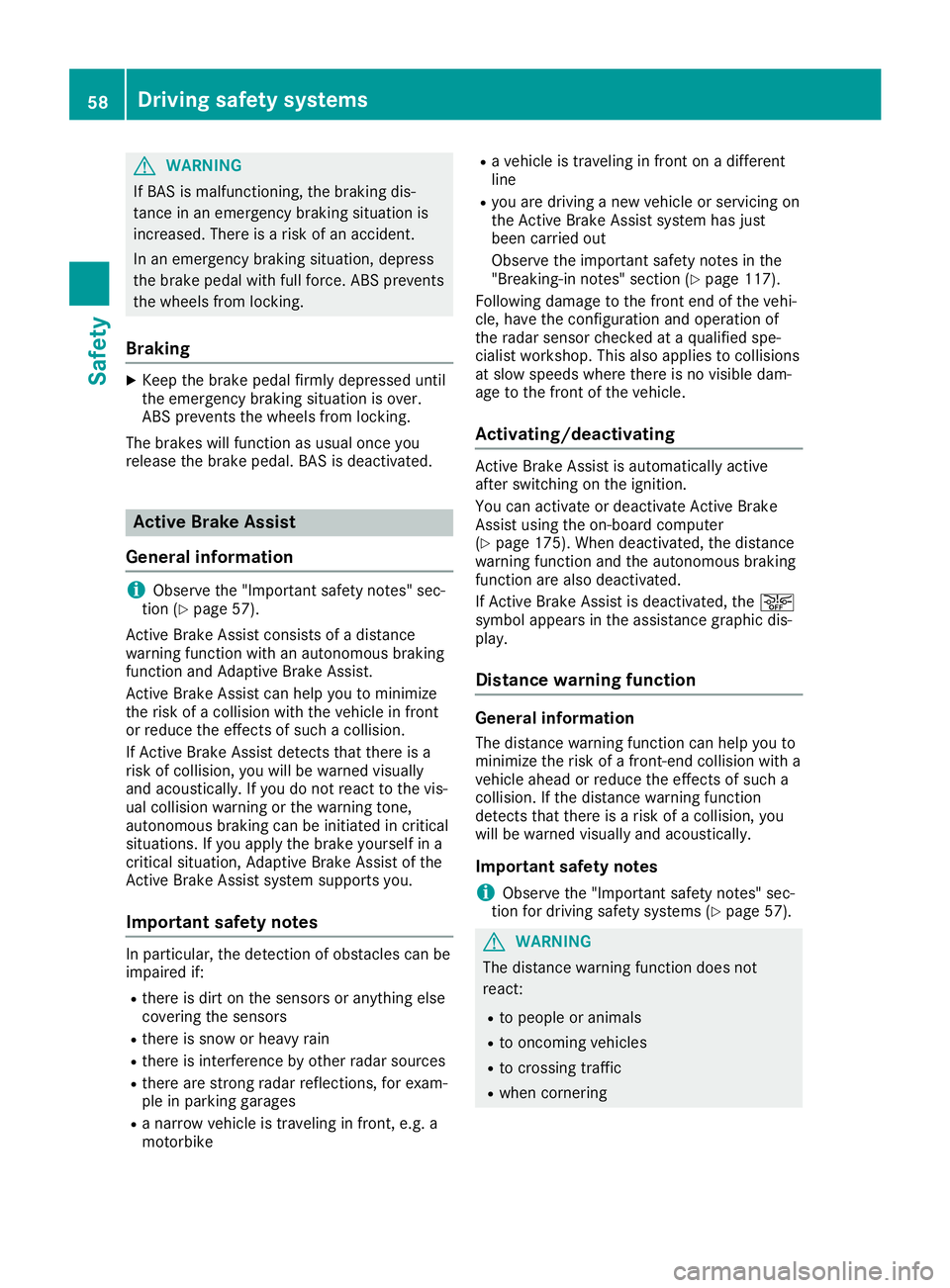
G
WARNING
If BAS ismalfu nctioning, thebraki ngdis-
tance inan emerge ncybraki ngsitua tionis
increas ed.There isarisk ofan accide nt.
In an emerge ncybraki ngsitua tion, depre ss
the brake pedalwith fullforce. ABSprevents
the whee lsfrom locking.
Braking X
Keep thebrake pedalfirmly depresseduntil
the emerge ncybraki ngsitua tionisover.
ABS prevents thewhee lsfrom locking.
The brakes willfunction asusu alonce you
rele ase thebrake pedal.BAS isdea ctivated. Ac
tive Brake Assist
Gene ralinfo rmation i
Observe
the"Impo rtantsafety notes" sec-
tion (Ypag e57).
Active BrakeAssist consists ofadista nce
war ning function withanautonomous braking
function andAdapti veBrake Assist.
Active BrakeAssist canhelp youtominimi ze
the risk ofacolli sion with thevehicl ein front
or redu cethe effects ofsuch acolli sion.
If Active BrakeAssist detects thatthere isa
risk ofcolli sion, youwillbe war ned visually
and acou stical ly.If you donot react tothe vis-
ua lcolli sion warning orthe warning tone,
au tonomous brakingcan beinitia tedincritical
situa tions. Ifyou applythe brake yourself ina
critical situation, Adapti veBrake Assist ofthe
Active BrakeAssist system supports you.
Important safetynotes In
particu lar,the detection ofobstacl escan be
impa iredif:
R there isdirt onthe sensors oranythi ngelse
covering thesensors
R there issnow orhea vyrain
R there isinterference byother radarsource s
R there arestrong radarreflectio ns,forexam-
ple inparki nggara ges
R anarrow vehicleis traveli nginfront, e.g.a
motorbike R
avehicl eis traveli nginfront onadiffer ent
line
R you aredrivi nganew vehicl eor servici ngon
the Active BrakeAssist system hasjust
been carrie dout
Observe theimporta ntsafety notesinthe
"Brea king-in notes"section (Ypag e117).
Follo wing dama getothe front endofthe vehi-
cle, have theconfigu rationandopera tionof
the rada rsensor checked ataqua lified spe-
cial istworksho p.This alsoapp liesto colli sions
at slow speedswhere thereisno visib ledam-
age tothe front ofthe vehicl e.
Ac tivating /deactivating Active
BrakeAssist isau tomatical lyactive
after switching onthe ignitio n.
You canactiva teor dea ctivate ActiveBrake
Assist using the on-board computer
(Y pag e175) .When deactivated, thedista nce
war ning function andtheautonomous braking
function arealsodea ctivated.
If Active BrakeAssist isdea ctivated, the00D4
symb olapp ears inthe assi stance graphicdis-
pla y.
Di stance warningfunctio n Gene
ralinfo rmation
The dista ncewarni ngfunction canhelp youto
minimi zethe risk ofafront-end collision with a
vehicl eahea dor redu cethe effects ofsuch a
colli sion. Ifthe dista ncewarni ngfunction
detects thatthere isarisk ofacolli sion, you
wil lbe warne dvisu allyand acou stical ly.
Important safetynotes
i Observe
the"Impo rtantsafety notes" sec-
tion fordrivi ngsafety systems (Ypag e57). G
WARNING
The dista ncewarni ngfunction doesnot
react:
R to peop leor anima ls
R to oncoming vehicles
R to crossing traffic
R when cornering 58
Drivi
ngsafety systemsSafety